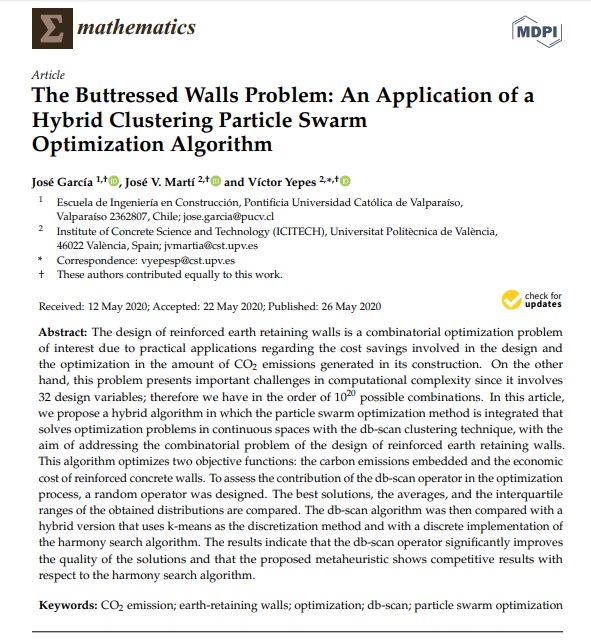 Acaban de publicarnos un artículo en la revista Mathematics, revista indexada en el primer cuartil del JCR. En este artículo se presenta un algoritmo híbrido de enjambre de partículas y clustering para optimizar el coste y las emisiones de CO2 de un muro de contrafuertes. El trabajo se enmarca dentro del proyecto de investigación DIMALIFE que dirijo como investigador principal en la Universitat Politècnica de València.
Acaban de publicarnos un artículo en la revista Mathematics, revista indexada en el primer cuartil del JCR. En este artículo se presenta un algoritmo híbrido de enjambre de partículas y clustering para optimizar el coste y las emisiones de CO2 de un muro de contrafuertes. El trabajo se enmarca dentro del proyecto de investigación DIMALIFE que dirijo como investigador principal en la Universitat Politècnica de València.
El diseño de los muros de contrafuertes es un problema de optimización combinatoria de interés debido a las aplicaciones prácticas relativas al ahorro de costos que implica el diseño y la optimización en la cantidad de emisiones de CO2 generadas en su construcción. Por otro lado, este problema presenta importantes retos en cuanto a complejidad computacional, pues involucra 32 variables de diseño, por lo que tenemos en el orden de 10^20 combinaciones posibles. En este artículo proponemos un algoritmo híbrido en el que se integra el método de optimización del enjambre de partículas que resuelve los problemas de optimización en espacios continuos con la técnica de clustering db-scan. Este algoritmo optimiza dos funciones objetivo: las emisiones de carbono y el costo económico de los muros de hormigón armado. Para evaluar la contribución del operador del db-scan en el proceso de optimización, se diseñó un operador aleatorio. Se comparan las mejores soluciones, los promedios y los rangos intercuartílicos de las distribuciones obtenidas. A continuación se comparó el algoritmo db-scan con una versión híbrida que utiliza k-means como método de discretización y con una implementación discreta del algoritmo de búsqueda de armonía. Los resultados indican que el operador db-scan mejora significativamente la calidad de las soluciones y que la metaheurística propuesta muestra resultados competitivos con respecto al algoritmo de búsqueda de armonía.
Abstract:
The design of reinforced earth retaining walls is a combinatorial optimization problem of interest due to practical applications regarding the cost savings involved in the design and the optimization in the amount of CO2 emissions generated in its construction. On the other hand, this problem presents important challenges in computational complexity since it involves 32 design variables; therefore we have in the order of 10^20 possible combinations. In this article, we propose a hybrid algorithm in which the particle swarm optimization method is integrated that solves optimization problems in continuous spaces with the db-scan clustering technique, with the aim of addressing the combinatorial problem of the design of reinforced earth retaining walls. This algorithm optimizes two objective functions: the carbon emissions embedded and the economic cost of reinforced concrete walls. To assess the contribution of the db-scan operator in the optimization process, a random operator was designed. The best solutions, the averages, and the interquartile ranges of the obtained distributions are compared. The db-scan algorithm was then compared with a hybrid version that uses k-means as the discretization method and with a discrete implementation of the harmony search algorithm. The results indicate that the db-scan operator significantly improves the quality of the solutions and that the proposed metaheuristic shows competitive results with respect to the harmony search algorithm.
Keywords:
CO2 emission; earth-retaining walls; optimization; db-scan; particle swarm optimization
Reference:
GARCÍA, J.; MARTÍ, J.V.; YEPES, V. (2020). The buttressed walls problem: An application of a hybrid clustering particle swarm optimization algorithm. Mathematics, 8(6):862. https://doi.org/10.3390/math8060862
